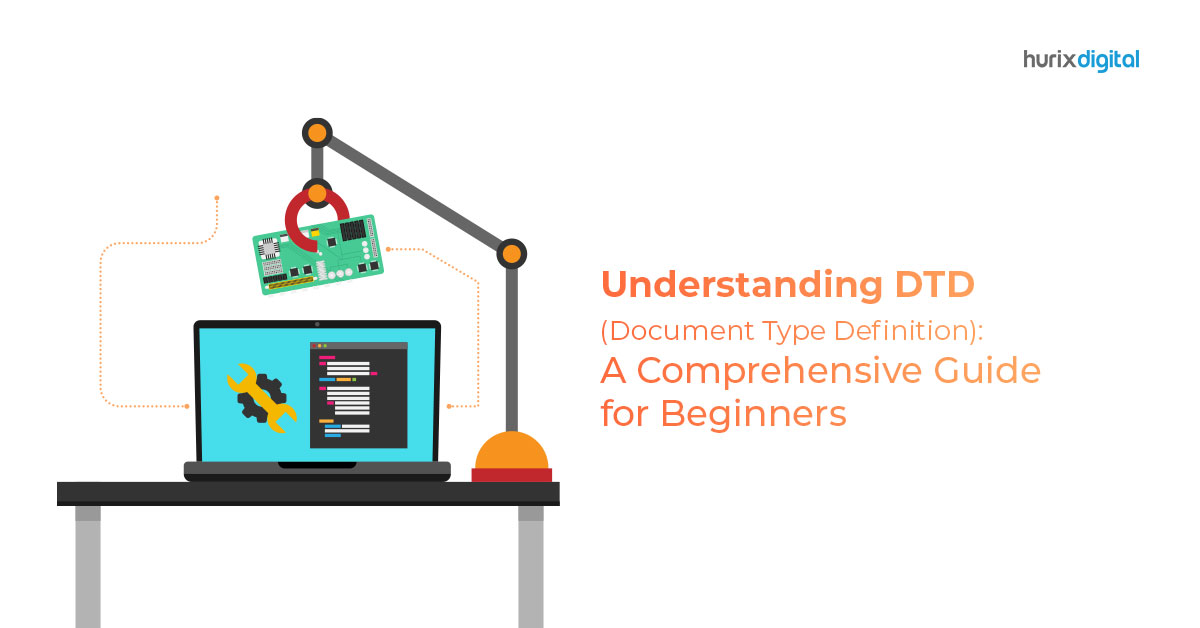Understanding DTD (Document Type Definition): A Comprehensive Guide for Beginners
In defining the structure and rules of an XML or HTML document, Document Type Definitions (DTD) play a crucial role in the web development realm. DTD serves as a blueprint outlining the components, attributes, and their correlation in a document. It is a set of guidelines establishing a particular kind of SGML family document, such as GML, SGML, HTML, and XML.
DTD, known as the XML Document Type Declaration, is a mechanism that accurately specifies the XML language. DTDs verify that an XML document’s vocabulary and structure adhere to the XML language’s relevant grammatical rules. It represents a contract between the parties creating and consuming the document by defining elements, properties, and their relationships.
Developers ensure that their documents are legitimate, properly structured, and interoperable across many platforms and systems by complying with the criteria specified in a DTD. This compliance allows the files to function seamlessly across various platforms and systems.
In this ultimate guide, we shall delve deep into DTD, its syntax, and its application and explore its relevance in contemporary web development.
Table of Contents:
- DTD Syntax Explained
- Fundamental Components of DTD Syntax
- Types of DTD
- Benefits of Using DTD
- The Bottom Line
DTD Syntax Explained
The Document Type Definition (DTD) is the most often used document model. DTD follows a specific syntax to define the structure and constraints of a document. DTDs predate XML, being derived from SGML with the syntax preserved almost entirely. Here is how a DTD specifies a document type:
- A DTD identifies a specific collection of permitted items, acting as the “vocabulary” of the language. Only element names included in this collection are allowed, while any other element names are not permitted.
- The content model specified in a DTD defines the structure of each element. It acts as the “grammar” of the language by determining the pattern of components or data contained within an element. The content model specifies the quantity, order, and whether they are mandatory or optional.
- A list of permitted attributes is declared for each element in a DTD. Each attribute declaration includes the name, datatype, possible default values, and behavior, such as whether the attribute is required or optional.
- It provides various tools and features, such as the “use of” mechanism, to simplify the management of the model.
Fundamental components of DTD syntax
1. Element Declaration
Elements represent the building blocks of a document. DTD declares elements using the ELEMENT ( <!DOCTYPE) keyword followed by the root element name and its content model. The content model can be defined as EMPTY, ANY, or a combination of other elements or data types.
Example:
php
Copy code
<!ELEMENT elementName contentModel>
2. Attribute Declaration
An attribute defines the property of an element, providing further information about its characteristics. A name-value pair represents an XML attribute in every instance. There are countless distinct attributes that an element might have.
In many aspects, attribute declarations are similar to element declarations, with one exception: rather than specifying the permitted attribute for an element, you declare a list of allowed attributes for each. These lists are known as ATTLIST declarations. They are defined using the ATTLIST keyword, followed by the element name, attribute name, attribute type, and default value (if any).
Example:
php
Copy code
<!ATTLIST elementName attributeName attributeType defaultValue>
3. Entity Declaration
Entities are a mechanism used to specify replacement values of content or special characters.
The entity values are specified in a line(defined within the DTD) or referenced via an external file. (external). The replaced entity value data is typically handled as XML and parsed. Entities are particularly useful for defining frequently used values or blocks of text, making the document more maintainable and modular.
Example:
php
Copy code
<!ENTITY entityName “entityValue”>
Comments: Comments can add explanatory notes within the DTD. They start with <!– and end with –>.
Example:
php
Copy code
<!– This is a comment in DTD →
Types of DTD
DTD declarations can be made inline or as an external recommendation within an XML document. There are two primary categories of DTD according to its usage.
-
Internal DTD
XML or HTML files define an internal DTD within them. The DTD declaration is independent of an external source while placed inside the document’s opening tag using the DOCTYPE keyword. Internal DTDs are suitable for small or standalone documents.
Example:
php
Copy code
<!DOCTYPE rootElement [
<!ELEMENT rootElement (childElement+)>
<!ELEMENT childElement (#PCDATA)>
]>
<rootElement>
<childElement>Content</childElement>
</rootElement>
-
External DTD
An external DTD is declared in a separate file outside the XML document. It is linked to the XML or HTML file and accessed by defining the system attributes using the SYSTEM or PUBLIC keyword in the DOCTYPE declaration. External DTDs are ideal for large or complex documents reused across multiple files.
Example:
php
Copy code
<!DOCTYPE rootElement SYSTEM “dtdFile.dtd”>
<rootElement>
<childElement>Content</childElement>
</rootElement>
Benefits of Using DTD
DTD, being the initial XML schema format, continues to be widely utilized in practice due to its simplicity, relatively easy comprehension, extensive support across XML parsers, and its ability to meet the requirements of most document structural specifications.
Although more modern data-interchange formats such as JSON and YAML have significantly replaced XML, understanding DTD remains relevant due to its continued use in specific domains. While DTD may not be as prevalent as it once was, it still offers several benefits.
1. Data Validation
DTD’s capacity to validate the structure and integrity of an XML document against a predetermined set of criteria helps identify errors, prevent inconsistencies, and maintain data integrity and quality. Programmers can leverage the DTD validation mechanism specifying the document’s elements, attributes, and constraints to verify that XML data conforms to a particular format.
2. Interoperability
DTD simplifies data integration between disparate systems, serving as a contract between data producers and consumers. It encourages interoperability by defining the rules and constraints for data exchange and demonstrating a standardized format for XML documents. Different systems can communicate and exchange data effectively by adhering to a uniform DTD.
3. Concise and Legacy Support
DTD, encompassing mature definitions that are comprehensive and intricate, is used for establishing numerous system interfaces. Rewriting these definitions may not justify the effort involved due to their existing robustness and complexity. Developers with a solid understanding of DTD can work with and alter existing XML files that rely on DTDs to ensure a seamless connection with legacy systems.
DTDs are often easier to interpret than recent schema languages like XML Schema or Relax NG. The concise and clear syntax makes it an ideal option where an uncomplicated solution is preferred.
4. Documentation and Contractual Agreements
DTDs act as documentation for XML structures, offering a precise specification for the expected data structure and content format of an XML document. This documentation aids developers in the development process serving as a reference guide and improving the overall readability and maintainability of XML files. DTDs can also serve as contracts that define the terms and conditions for XML data interchange between data producers and consumers.
The Bottom Line
DTDs have a long history and are well-established in the XML ecosystem. Several XML-related tools and libraries support DTDs natively, making it easier to work with XML documents that utilize DTDs.
While the relevance of DTD has diminished with the rise of alternative modern schema languages and data interchange protocols, the significance of understanding DTD remains intact for ensuring compatibility and understanding of the foundations of XML. Developers can effectively work with existing XML systems and leverage its benefits when necessary by mastering the underlying principles of DTD.
We get it—technology can sometimes feel daunting and perplexing. But don’t worry! Our team of experts is here to guide you through the entire process. From setting up courses and monitoring your student’s progress to creating custom solutions exclusively for you, we have your back. Contact us today and discover how Hurix can help you achieve your goals.
Also Read – All You Need to Know About XML & DTD

Passionate about developing innovative business models for customers in the content space. Primarily focused on the markets: US, UK, Europe, Middle East and APAC with 18 years of experience. Focused on collaborative working with internal teams such as Technology, Operations, Finance, and Marketing to ensure the voice of the customer is in everything that the company builds.









